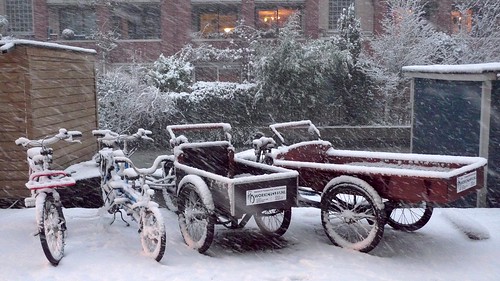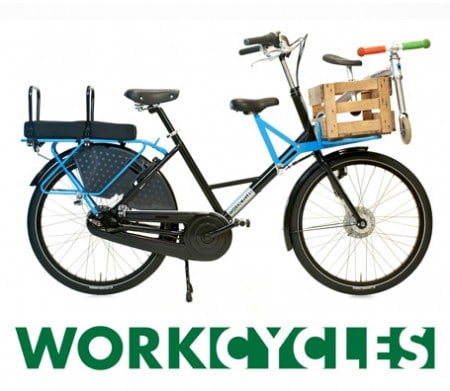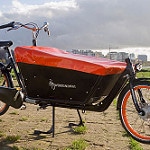Finally: A Real Winter in Amsterdam
TweetThe last few winters have been pretty wimpy; hardly any snow and not even particularly cold. Actually that’s not entirely true since there’s nothing more bone chilling than a rainy, windy day just above the freezing point. The Dutch call it “waterkoud” meaning “water cold”, though it doesn’t prevent them from cycling like their water soluble cycling neighbors.
This winter began in November. It rained for weeks and weeks and weeks, right through much of December. It was apparently the rainiest November since the Golden Age… or something like that. Fortunately we were in Japan enjoying perfect weather. Then in late December it got colder and the rain turned to snow. Of course we’re talking about Amsterdam here so it’s never very much snow, but at least it’s been snowing regularly and the snow’s been sticking around for long enough to have some winter wonderland. Cycling in the snow is fun, especially in a city where the distances are short and you can largely avoid cars. I’ve always loved the quietness and lightness of a snowy city, I assume the result of the snow absorbing sound and reflecting light far better than most of what’s under the snow.
This afternoon poked my camera out the door to snap the above picture. Good thing those bikes aren’t spring flowers but no takers for a bakfiets rental this evening?



















January 8th, 2010 at 17:26
Henry,
will any of your bikes accommodate studded tires? The crucial point would be fender clearance, I suppose.
Winter-cycling greetings from northern Norway!
January 8th, 2010 at 19:22
Hal: To paraphrase Mikael the Viking Van Copenhagen, “Just relax and slow down.” Oh, wait, um, you are in Norway. Never mind.
January 10th, 2010 at 17:22
What I also like to see in the streets now is the supremacy of the bicycle for commuting. While cars all came to a standstill on the highways around Amsterdam in perhaps the biggest traffic jam ever, trains were cancelled or delayed, pedestrians were sliding and shuffling slowly, you could still see bicyclists plowing through the snow with only a slightly reduced speed. At work, only the bicyclists showed up early, the rest was stuck in traffic. It did help that the City of Amsterdam cleared most bicycle paths.
January 11th, 2010 at 08:48
Hal,
Studded tires are overkill in Holland but for those in more extreme climates I’m pretty sure there’s a studded tire to fit almost all of our bikes. Schwalbe makes a Winter version of the Marathon with studs. The 35mm version is perfect for the Secret Service and the 42mm for our classic city bikes. Continental also makes the Topcontact Winter which has a sharp granulate filling in the rubber. They claim that has a similar effect to studs but little or no influence on riding on clean pavement. For the Fr8 Schalbe makes the Icespiker in 54-559 but it’s an expensive tire. The Schwalbe Winter Marathon comes in 47-559 – a little small but the extra clearance is handy for winter.
January 11th, 2010 at 09:01
Reinder,
I’ve also been watching how much more reliable cycling is than any other means of transportation here. Not only has the city been very consistent in clearing the bike paths, it seems that even with equal treatment the bike paths are safer. Last night I was cycling and found that the car roads were solid sheets of ice, as if the soft, fat, warm car tires compact the snow into ice. The bike paths, on the other hand, were mostly mushed up snow and slush; not fast but fairly safe to ride on. It seems that the comparatively high pressure, narrow bike tires cut the snow up.
In any case cycling from A to B generally takes the same amount of time, regardless of weather and traffic conditions. Considering that one must leave as much time for a journey as the maximum possible journey duration driving a car becomes quite time consuming in reality. Even when cycling is generally a little slower, it might not be slower than the time that must be allowed for the inconsistencies of driving.
January 11th, 2010 at 09:52
Henry,
thanks for your reply. Although studs probably are overkill in the Netherlands, up here they are just the ticket. I have Schwalbe Ice Spikers on my trusty ’94 Specialized Hardrock Ultra and would not feel safe without them – especially with a 3-year-old on the top tupe.
I’ve been drooling over your bikes for some time now, and contemplating a trip to A’dam in summer.
Or maybe I’ll build a new rear wheel with a Nexus hub for the old Hardrock. It has been working well as a single since the gears wore out for the second time a couple years ago, but next year I’ll be carrying two kids, and we have hills here 🙂
All the best to y’all.
January 11th, 2010 at 21:54
I used the Hakkapeliitta A10 studded tyres for a few winters. Very nice grip, even in ruts. Now I just use Schwalbe Marathons or equivalent all year round. They are quite good even for winter conditions, in my opinion.
Studded tyres are nice to have, but often you get by without them, by just slowing down a little as required.
January 11th, 2010 at 22:08
Erik,
Thanks for the input. It seems to be a sensible approach that studded bike tires are really something for a fairly harsh climate or cycling daily in an area where the roads are poorly cleared. I’ve ridden my bike everywhere in New York, Vermont, Colorado and now Holland without using studs… but in retrospect they sure would have been handy in Vermont and Colorado.
But on the other hand some people really don’t want to risk a fall while cycling and studded tires are cheap insurance with little downside aside from the hassle and small cost. This could be because they’re elderly and breaking a bone could be catastrophic or perhaps because they carry children.
In the last weeks my wife and I have only been carrying our son in box of the bakfiets and not in the seat behind the handlebar of our standard bike. Not only does the heavy bakfiets ride very solidly in snow, the child is well protected in the box and canopy. In fact Kyoko had a (her first) small spill on ice today. The weight of the bike falling on her leg was painful but Pascal didn’t even mind sitting in the sideways box.
January 11th, 2010 at 23:02
Henry, you mention now the stability of the two-wheeled bakfiets, but in a previous post have mentioned that some preferred three-wheelers because of icy conditions.
Would some kind of quick-release training wheels-like thing be helpful? They could be mounted on the bottom of the box and then swing down, etc. Or is this a solution looking for a pandemic? (Actually, what about training wheels? Do most kids now use those scoot bikes at first and then progress to the adult stuff?).
Now and earlier you have said how kids can find it funny or at least okay to be strapped in while the bikes they are in turn over. Can you create a large, expensive 3-D interactive entertainment product based on this, so that children around the world can experience this thrill and joy?
January 11th, 2010 at 23:36
Todd, there’s a big difference between snow and ice. The heavy, long wheelbase two-wheeled bakfiets seems very stable and easy to ride on snowy and slushy roads, and even if you do fall the kids are well protected. Of course a three wheeler is even more stable but my experience on trikes is that they usually suck eggs on uneven terrain; one front wheel gets pulled to the side. But it’s just unpleasant; it doesn’t fall over.
Like studded tires I think it would take a pretty extreme climate to justify having to ride a three wheeler all year. Unlike studded tires you can’t just make your triike a bike the rest of the year.
Forget about side-wheels, gyroscopic stability systems such as on the amazing, old Schilovski two-wheeled Gyro-Car and other crazy ways of preventing your bike from falling over. If the conditions warrant it, put studded tires on the beast and ride with probably as much security as on wet pavement with regular tires. End of story.
Yes, concerning training wheels… these are on their way to extinction in the Netherlands. most kids learn to ride a bike on a “loopfiets” (“balance bike” or “walk bike”). Seventeen month old Pascal can already paddle around on one in the shop and if the roads weren’t covered with snow, slush and ice he’d probably already be riding it.
January 11th, 2010 at 23:52
Thanks, Henry… I am always ready to ask the possibly silly questions. Also, what is the best Dutch translation of \suck eggs\?
January 17th, 2010 at 22:07
henry, same here in berlin — only even more so 🙂
https://www.flickr.com/photos/tlossen/4263080297/